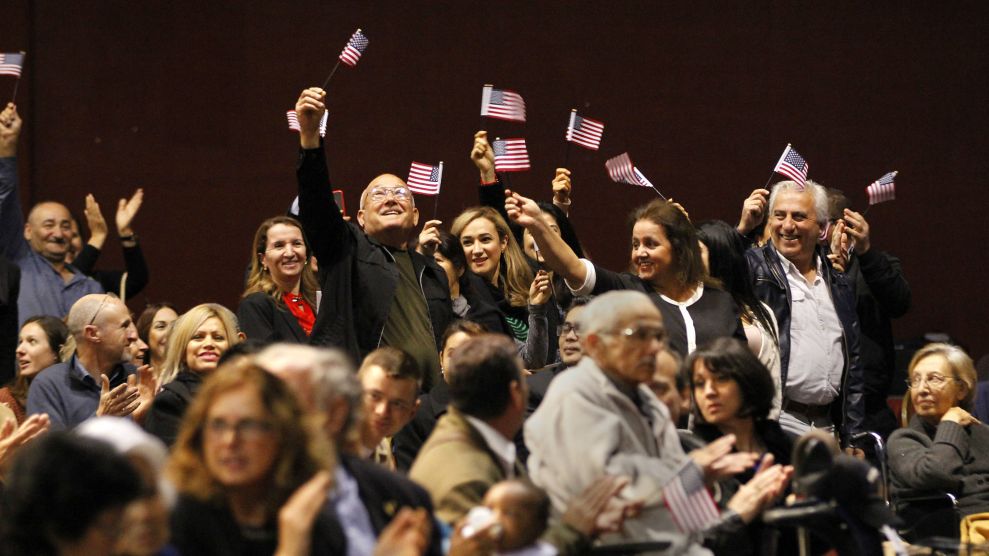
Students arrive by bus at the University of Central Missouri's satellite campus in Lee's Summit, Missouri.Barrett Emke
On a late-summer morning in Lee’s Summit, Missouri, two buses approached a low-slung building. The warehouselike facility in this Kansas City suburb was actually a branch of the University of Central Missouri, whose main campus was 40 miles away in rural Warrensburg. Nearly 90 percent of UCM students hail from Missouri. But this morning, almost all the 40 or so who hopped off the buses were from India. To get there, some had taken out loans against their parents’ homes; whole families had pooled funds to send over just one student. Wearing jeans, hoodies, and the occasional salwar kameez, they headed to computer science and information technology classes through a pair of double doors, past a looming decal of the school mascot, Mo the Mule.
It was two years ago that Poonam Gohil first rode that bus. Petite with a round face and shoulder-length black hair that swoops over her right eye, Gohil had come from Mumbai to get ahead. She’d seen Indian friends leave for the United States and secure good-paying jobs at well-known companies, and she decided to attend UCM because of the school’s relatively low cost—students can earn a master’s degree in computer science for about $15,000. It was still a big stretch, especially since Gohil’s parents had passed away when she was young, but she cobbled together scholarships, awards, and a job at a coffee shop to help pay her way.
Gohil arrived on campus as the Indian student population at UCM was skyrocketing, jumping from just 152 in 2012 to nearly 2,500 in 2015—some 17 percent of the university’s student body. The school had become a newly popular destination thanks to a little-known but fast-growing guest worker program called Optional Practical Training, which allows foreign students earning degrees from American institutions to work in their field for a year after graduation. Those with degrees in science, technology, engineering, or mathematics can stay in the United States for up to three years.
That’s also how long foreigners can stay under the better known (and more restrictive) H-1B skilled-worker visa, which limits guest workers to the position described on their application and requires companies to pay to sponsor them before they start working, making it difficult for them to switch jobs. The flexibility of the OPT program is one reason why its numbers increased 39 percent between 2014 and 2016, and why nearly two times more OPTs were approved than H-1Bs last year. With more than 300,000 OPTs currently working in the United States, according to the federal government, the program has become a key part of the tech industry’s efforts to recruit globally.
Gohil thrived at UCM. She hoped that by excelling, she’d set herself up to score a well-paying gig in the United States. Most graduate students do an internship in their last semester; she was one of a few computer science students who elected to write a thesis, analyzing real-time edits to Wikipedia to improve its trustworthiness. When I met with Gohil on campus in April, a Saudi Arabian classmate walked by and inquired about her thesis. “You didn’t see my WhatsApp status?” Gohil asked. “I won an award!”

Former University of Central Missouri student Poonam Gohil outside her home in Warrensburg, Missouri.
Barrett Emke
Yet like many of her Indian classmates, Gohil was stressed out about the job search. She’d applied for positions with dozens of major companies but secured only a handful of interviews—and no calls back. “It was heartbreaking,” Gohil told me. Meanwhile, she’d started receiving multiple text messages and emails from aggressive contractors at tiny firms she’d never heard of. “Do you have any other good Referrals?” one text to Gohil read. “Text me their Names and Ph Nos.. You will get referral bonus from us…” Others approached Gohil on LinkedIn, asking her to work for them and offering her $1,000 for every person she brought with her. Soon enough, she figured, she’d have to settle for a contract job at one of these cut-rate temp firms. After all, if she couldn’t find an employer to sponsor her OPT, she’d have to go back home to India.
For many foreign students like Gohil, the OPT program has become a pathway into a shadowy world of white-collar indentured servitude. For every graduate who lands a job at Amazon, Intel, or Microsoft, many more end up laboring at small companies known as “body shops” that specialize in contracting tech workers for IT and software development roles at larger firms, usually for short-term projects. Often run by Indian immigrants themselves, the labor brokers entice workers with the claim to make $50,000 or so per year. That sounds pretty good for a new graduate, until you understand what strings are attached.
Body shops have long run afoul of federal labor laws. In 2014, the Center for Investigative Reporting found that firms illegally withheld nearly $30 million from some 4,400 tech workers on H-1B visas from 2000 to 2013. CIR also reported that they regularly used restrictive employment contracts to keep H-1B holders from leaving for permanent jobs, and even sued them for quitting, sometimes for as much as $50,000 in damages. (In 2013, the Labor Department cited six tech consultancies for trying to impose illegal penalties on workers who’d left their jobs.) Additionally, the CIR investigation gave an example of a body shop that forced workers to exaggerate or falsify their résumés to make them appear more attractive to large end clients.
Now, according to lawsuits involving Silicon Valley-area body shops and interviews I conducted with three dozen foreign guest workers, these practices have spread to the OPT program. But the difference is that universities are willing partners too. Eager to make up for funding shortfalls in the wake of the Great Recession, schools across the country have enrolled larger shares of international students, many of whom pay full freight.
Hal Salzman, a tech labor expert and public policy professor at Rutgers University, told me that, given the demand, colleges are incentivized to quickly set up grad programs and start charging for degrees that let students join guest worker programs. “And with the OPT,” he said, “they can enter without any wage protection, job protection, or other kinds of minimal labor conditions.”
Some OPTs believe they’ll be able to pay off their student loans once they score a job after graduation. Although college officials must sign off on a student’s employment, their vetting of companies is so lax that it amounts to a rubber stamp, giving shadowy operators a chance to gain a foothold on campus.
For example, a New Jersey-based company named Friendly Consultants Inc. was among the body shops that reached out to Gohil. In the fall of 2015, it was the sole sponsor of the Indian student association’s celebration of Diwali, the Hindu festival of lights, which she had helped organize; during the event, Friendly held a raffle with a sign-up sheet collecting the names, email addresses, phone numbers, and expected graduation dates of dozens of students.
On its website, Friendly boasts about its sponsorship of the UCM event, as well as other events at Kent State University, Northwest Missouri State University, and the University of Akron. But of the roughly two dozen reviews of the company on MyVisaJobs.com, a sort of Glassdoor for guest workers, the overwhelming majority were extremely negative, with several warning prospective employees to avoid Friendly altogether. (Friendly did not respond to multiple requests for comment.)
Gohil never returned Friendly’s messages. A few weeks after I spent time with her in Warrensburg, she texted to let me know she’d finally landed the interview she’d been dreaming about: Amazon. The company had an opening for an entry-level software development engineer, and she was flying to Washington, DC, in two weeks. If all went well, she’d start the new gig in the summer—and put Friendly and the other body shops behind her.
When UCM turned to international recruiting around 2010, administrators knew what Indian students were looking for: instruction in STEM fields, then an OPT, and then, in a best-case scenario, an H-1B. (Of the 85,000 H-1B visas offered each year, 20,000 are reserved for people who have earned a master’s degree or higher from a US institution.) According to Mike Godard, UCM’s vice provost for enrollment management, the school hired several carefully vetted education agents in India to direct students to UCM. But the 1,500 percent increase in Indian enrollment at UCM still shocked university leaders. “I don’t think anyone in their right mind would have predicted that type of spike,” Godard said.
Of the million or so foreigners studying at American universities, 16 percent come from India. At last count, there were more than 90,000 Indian OPTs in the United States—more than double the number in 2010. Houston-based immigration attorney Emily Neumann, whose firm is a go-to for consulting companies filing visa applications for Indian workers, said UCM suddenly popped up on her radar this year. She had prepared H-1B visa applications for several students who attended the school. “With the Indian community, it’s so close-knit,” she said. “So if their relatives say, ‘I graduated, the classes were easy, I didn’t have any trouble getting my H-1B and my OPT,’ all of their friends are going to start going to the school.”

University of Central Missouri student Vicky Reddy near Lions Lake in Warrensburg, Missouri.
Barrett Emke
One of those students is Pradyumna Reddy, a rangy, stylish industrial-management major from Hyderabad who goes by the nickname Vicky and lives in a two-bedroom apartment with three roommates near UCM’s Warrensburg campus. When I visited in the spring, Indian students were renting all six units in his building, and all of them were OPT-bound. Vicky shared a room with a computer science major, and their beds consisted of two piles of blankets arranged within a few inches of each other on the ground. The apartment’s lone luxury was a new smart TV sitting on the box it came in; the walls were bare save for a map where Vicky had traced the routes he’d driven in the used Chevy Cruze he bought when he moved to Missouri. In the kitchen, there was a rice cooker, a pile of dishes, and a 50-pound bag of onions from a restaurant-supply store in Kansas City. Onions, Vicky explained, are expensive at Walmart.
Vicky came to UCM after a stint at the University of New Haven, a private school in Connecticut that was so expensive he blew through almost a quarter of his $50,000 loan in just one semester. He plans to complete his master’s in December. Because his undergraduate degree is in mechanical engineering, he didn’t have the prerequisites to study computer science and opted for industrial management instead. He’s hoping that doesn’t prevent him from catching on with a body shop: If Vicky isn’t able to pay back his debt, his father’s wages will be garnished to cover it. The pressure to work in the United States, first as an OPT and then on an H-1B, is massive. “I don’t want to be blamed,” he told me. “My relatives will say, ‘You didn’t get any job. Are you not worth it?’ That’s how people think.”
According to data I requested under the Freedom of Information Act, UCM ranked 26th in the number of approved OPTs in the workforce since 2011, behind elite schools like Columbia and Carnegie Mellon. But also ahead of UCM in the rankings was Northwestern Polytechnic University, a California school that BuzzFeed exposed in 2016 for enrolling thousands of foreign students—making up 99 percent of its student body—but having no full-time, permanent faculty. While graduates from name-brand schools frequently found their way to Fortune 500 companies like Goldman Sachs, Microsoft, Google, and Apple, UCM graduates seem indistinguishable from those who attended Northwestern Polytechnic—both often move straight from the classroom to obscure tech firms.
As UCM’s Indian population has surged, problems with the OPT program have emerged. Promatrix Corp.—a New Jersey firm that sent representatives to a UCM career fair in the spring of 2015—was ensnared in an elaborate sting operation set up by the US government in which federal agents created a fake school, the University of Northern New Jersey, to trap companies misusing the student visa system. In early 2016, the Justice Department brought a complaint against the firm’s CEO and managing director, Tejesh Kodali, and another employee for conspiracy to commit visa fraud and harbor immigrants for profit. Kodali pleaded guilty to a visa fraud conspiracy charge in late 2016.
There’s no legal obligation for schools to vet employers recruiting on campus, according to Edwin Koc of the National Association of Colleges and Employers, the professional association for career service counselors. And in the case of public universities, these counselors have to be careful to avoid discriminating against a particular type of firm.
With little oversight from their institutions, students can land at body shops like SCM Data and MMC Systems, two East Coast firms that were accused by a Homeland Security agent in a 2015 court case of coaching students to lie to the government about their work to obtain H-1B visas. Court documents also claim that the companies failed to pay some guest workers, despite promises of $27 an hour.
Prathiba Kalyan, a New Jersey-based staffing specialist who places body-shop consultants with her clients, says the OPTs she has encountered are “just left out to fend for themselves. These institutions that are just spewing out these degrees aren’t making any attempt to give them a career path.”

Vicky Reddy records his travels throughout the United States on a map at home in Warrensburg, Missouri.
Barrett Emke
When I asked UCM’s dean of international affairs, Joseph Lewandowski, about the high number of alumni ending up at body shops, he called the trend “alarming.” But UCM isn’t alone. A computer science professor at Central Michigan University said approving students’ applications for OPT at the school amounted to double-checking to make sure that forms were filled out correctly. “All I needed was a piece of paper from an employer,” the professor told me. “They didn’t even have to tell me how much money they were paying. They just had to tell me they’re employed.”
In 2015, Central Michigan awarded more than 150 master’s degrees in computer science, three times more than it had handed out the year prior. Nearly 85 percent of them went to international students, the bulk from India. According to department chair Pat Kinnicutt, the school temporarily offered in-state tuition to foreign students and didn’t require a minimum score on the GRE. The floodgates opened. In 2016, it rescinded both perks.
“The large number of students definitely impacted the quality of education—lowered it,” Kinnicutt said. Unsurprisingly, almost all students took opportunities to work in the United States, including via OPT. “All our students do get jobs,” he said.
So how do OPT students—and the companies they work for—fare? When Chetan Reddy Kottur graduated in 2011 from Southern University, a historically black college, he immediately set off for a Dallas-area body shop called Saxon Global. The company gave him temporary housing near its office, placing him with five other Indian guys in a two-bedroom apartment. He slept on the floor in what would have been the dining room for months. During that time, he says, he fabricated his résumé because he believed that’s what was expected of him. (According to a former employee of an Atlanta-based body shop, inflating guest worker experience is rampant in the industry.) Saxon marketed Kottur as a business intelligence developer, claiming he had previously created reports using companies’ internal data to improve their decision making.
One of the résumés Kottur used stated he had seven years of work experience at American companies like McGraw-Hill Education and a Campus Federal bank in Baton Rouge, Louisiana. (He was only 25 at the time.) Thanks to a bogus résumé and something known as a proxy call—in which a more seasoned worker takes a phone interview with a potential client on behalf of a newbie—he landed a gig in Indianapolis at Simon Property Group, the country’s largest shopping-mall operator. “I was scared the shit to death,” Kottur recalled. “I thought, ‘How am I going to do the job?'”
Luckily, his team included others from his hometown of Hyderabad, and they helped pull him along through the end of the six-month project. But a few months later, when he started a new posting at the HMO Kaiser Permanente in Pleasanton, California, Kottur was unable to answer a series of technical questions from his boss and was fired on the spot. “I thought this was the only way,” Kottur said. “Every day, my heart was pounding so much. Usually, I would know in one month whether I would survive or not.” (Saxon Global CEO Gopi Kandukuri vehemently denied Kottur’s account.)
Kottur worked for another body shop after Saxon Global, but he has since left consultancies behind. He now works at a mortgage insurance company in North Carolina. In early February, he posted a testimonial-style video to YouTube. In it, he decries the body-shop model and encourages others who have been through it to tell their stories. It has more than 26,000 views and nearly 100 comments. “Please come out,” Kottur implores, peering through purple-rimmed plastic glasses. “If you constantly let these people take advantage of you, none of this will stop.”
During the presidential campaign, Donald Trump repeatedly hammered the tech industry for relying on immigrants—particularly those with H-1Bs. He singled out Disney for laying off portions of its workforce after signing outsourcing contracts with a large Indian IT services company—and forcing the pink-slipped workers to train their H-1B replacements. Demand for H-1Bs has far outstripped supply in each of the past five years, which is why the Department of Homeland Security hands them out via lottery: In 2016, there were a record 236,000 applications for just 85,000 new visas. In April, Trump ordered a review of the visa-granting process, and though any real changes will require Congress to pass legislation, his rhetoric appears to have had an impact. There were 37,000 fewer H-1B applications filed for the 2017 lottery as compared with 2016.
Yet for all the debate raging over H-1Bs, the OPT program—which has no enrollment cap—has flown under the radar to become the surer, bigger path for Indians to temporarily work in the United States. Recently, Pravin Rao, the chief operating officer of outsourcing firm Infosys, told India’s Economic Times that his company (which has secured thousands of H-1Bs over the years) was now “looking at hiring from more colleges in the US.” Instead of facing the scrutiny that goes with importing midlevel workers from India, it could use the OPT program to take advantage of resources already in the United States.
Meanwhile, Poonam Gohil will be one of thousands of OPT students looking for work this fall: When I checked back with her, she told me she didn’t get the Amazon job. Worse, her employment authorization card was due in mid-July; at that point, she’d have just a few months to secure an employer. Otherwise, she’d have to return to Mumbai.
“Right now, I just feel like it’s really hard to get a job here,” Gohil told me, adding that she’s still leery of going to work at a body shop. “I was better off in India.”
This article was supported by an Ida B. Wells Fellowship from The Investigative Fund at The Nation Institute.















